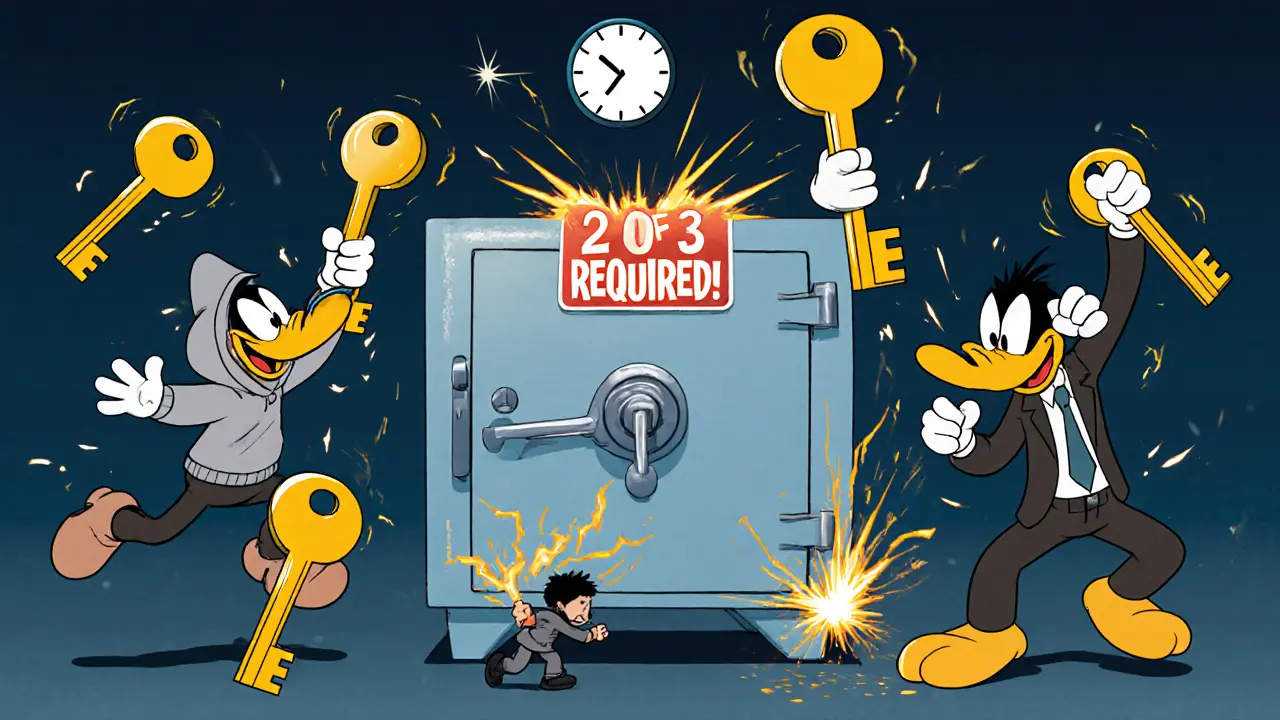What Are Multi-Signature Crypto Wallets and Why They Matter for Security
 Nov, 13 2025
Nov, 13 2025
Multi-Signature Wallet Security Calculator
Find Your Ideal Multi-Signature Wallet Configuration
Answer a few questions to determine the best M-of-N setup for your needs. This calculator helps balance security with usability based on your specific situation.
Imagine you have a safe at home. Normally, one key opens it. But what if you needed two people to turn their keys at the same time to open it? That’s the idea behind a multi-signature crypto wallet. It’s not just a fancy upgrade-it’s a fundamental shift in how you protect your digital assets. Instead of relying on one private key that, if lost or stolen, means total loss, multi-sig requires multiple approvals before any transaction can go through. This isn’t science fiction. It’s how institutions, DAOs, and serious holders secure billions in cryptocurrency today.
How Multi-Signature Wallets Work
A multi-signature wallet doesn’t store your crypto differently than a regular wallet. The difference is in the rules. Think of it like a smart contract that says: “You need at least M signatures out of N total keys to move funds.” This is called an M-of-N setup. The most common configuration is 2-of-3: you have three separate keys, and any two of them can authorize a transaction.
Here’s how it plays out in practice. Let’s say you set up a 2-of-3 wallet. You keep one key on your phone, another on a hardware device at home, and the third with a trusted friend in another city. If someone hacks your phone, they can’t move your funds-they only have one key. If your hardware wallet breaks, you still have two other keys to recover. No single point of failure. That’s the core value.
When you want to send crypto, you start the transaction. It sits in a pending state until enough signatures are collected. Once the threshold is met, the wallet broadcasts it to the blockchain. This process takes longer than a single-key transaction-around 3.2 minutes on average for 2-of-3 setups-but that delay is the price of safety. You’re not just securing against hackers. You’re also protecting against internal risks: a rogue employee, a coerced transfer, or even a family member accidentally spending your life savings.
Why Multi-Sig Is the Standard for Institutions
If you look at who’s using multi-sig wallets, the pattern is clear: it’s not casual users. It’s organizations that can’t afford to lose a single dollar. According to Coinbase’s 2023 data, 78% of crypto businesses managing over $100,000 use multi-sig. For DAOs, the number is even higher-over $22 billion in treasury assets are secured by multi-sig setups as of mid-2023.
Why? Because single-key wallets are dangerous. Coinbase’s 2022 security report found that 98% of exchange hacks happened because they relied on one private key. One breach. One mistake. Total loss. Multi-sig changes that equation. In Q1 2023 alone, DAOs using 3-of-5 multi-sig wallets blocked $4.7 million in attempted fraudulent transfers. One team member got phished. The other four keys held firm. No funds moved.
Institutional giants like Fidelity Digital Assets now require multi-sig for all client holdings over $500,000. The U.S. Office of the Comptroller of the Currency confirmed in 2022 that properly configured multi-sig meets legal standards for “dual control and segregation of duties”-essentially making it compliant banking-grade security.

Real-World Use Cases
Multi-sig isn’t just for big companies. It’s useful in any situation where control should be shared.
- DAOs and Treasury Management: Projects like Aave and Uniswap use 3-of-5 or 4-of-7 setups to prevent any single person from draining the treasury. Votes are tied to key ownership.
- Businesses and Teams: A startup with three founders might use a 2-of-3 wallet so no one can spend company funds without approval from at least one other person.
- Family Inheritance: You can set up a 2-of-3 wallet where one key is yours, one is with your spouse, and one is held by your lawyer. If something happens to you, your family can recover funds without needing your password.
- Joint Accounts: Couples or business partners can use multi-sig to manage shared crypto holdings without giving full control to either party.
Even individual users benefit. A 2023 Reddit user named u/DeFi_Treasury_Manager reported that their 3-of-5 wallet stopped a $2.1 million social engineering attack. One team member clicked a fake link. The other four keys didn’t respond. The scam failed.
The Downsides: Complexity and Coordination
Multi-sig isn’t magic. It’s harder. And that’s the trade-off.
Setting up a 2-of-3 wallet can take 6 to 10 hours. You need to generate keys securely, store them in different places, test recovery, and document everything. A 2023 Ledger Academy study found that 63% of new users needed extra training just to understand the basics. Mistakes happen. One common failure? Keeping all keys in the same physical location. If your house burns down and all your hardware wallets are inside, you lose everything-even with multi-sig.
Transaction speed is slower. Approval times are 47% longer than single-key wallets, according to BitPay. And mobile support? Only 32% of multi-sig services offer full mobile signing. If you’re on the go and need to move funds fast, you might be stuck waiting for someone else to approve.
Recovery is another pain point. If one keyholder disappears-say, they leave the company or pass away-recovery can get messy. You need a pre-planned process. That’s why newer systems like Safe (formerly Gnosis Safe) now offer “social guardians.” These are trusted contacts who can help initiate recovery without holding a signing key. It’s like having a backup plan that doesn’t rely on crypto keys alone.

Multi-Sig vs. Single-Signature Wallets
Here’s the simple comparison:
| Feature | Multi-Signature Wallet | Single-Signature Wallet |
|---|---|---|
| Security | High-requires multiple approvals | Low-single point of failure |
| Transaction Speed | Slower (avg. 3.2 min for 2-of-3) | Faster (avg. 1.1 min) |
| Setup Complexity | High-requires planning and coordination | Low-just one key |
| Best For | Institutions, teams, DAOs, inheritance | Individuals, casual users, small amounts |
| Adoption Rate (Institutions) | 83% of assets over $1M use multi-sig | Only 12% of institutional users |
| Adoption Rate (Retail) | 7% of retail users | 93% of retail users |
For most people holding small amounts of crypto, a single-key wallet is fine. But if you’re holding significant value-whether it’s $10,000 or $10 million-multi-sig is the only responsible choice. The risk of losing everything to one hack or one bad decision is too high.
The Future of Multi-Signature Wallets
Multi-sig is evolving. The next wave includes:
- Post-quantum cryptography: BitGo is integrating quantum-resistant signatures to protect against future threats from quantum computers.
- Native blockchain support: Ethereum’s EIP-3074 aims to build multi-sig directly into the protocol by 2025, making it faster and cheaper to use.
- Integration with social recovery: Services like Safe now let you name trusted friends or family as recovery contacts, reducing reliance on hardware keys alone.
The trend is clear: as crypto moves from speculation to serious finance, security can’t be an afterthought. Multi-sig has gone from a niche tool to essential infrastructure. BitPay reports that 100% of their business clients now require multi-sig-up from just 42% in 2020. That’s not a fluke. It’s a response to real losses, real hacks, and real accountability.
For individuals, the barrier is still high. But tools are getting better. If you’re serious about holding crypto long-term, learning multi-sig isn’t optional. It’s the difference between sleeping well at night and wondering if your keys are safe.
Do I need a multi-signature wallet if I only hold a small amount of crypto?
If you’re holding less than $5,000 and don’t plan to grow your holdings significantly, a single-signature wallet is usually fine. But if you’re storing crypto for the long term-even small amounts-multi-sig adds a layer of protection that’s hard to beat. The cost of a breach isn’t just financial; it’s emotional. Once you’ve lost crypto, there’s no reset button.
Can I use multi-sig on my phone?
Yes, but with limits. Only about 32% of multi-sig services offer full mobile signing capabilities. Most require hardware wallets or desktop apps for signing. You can initiate transactions from your phone, but final approvals often need a separate device. This is intentional-it keeps keys separated for security.
What happens if one of my signers loses their key?
It depends on your setup. In a 2-of-3 wallet, losing one key doesn’t lock you out-you still have two others. But if you lose two keys, you’re stuck. That’s why key distribution is critical. Never store all keys in the same place. Use different devices, locations, and even people. Consider backup solutions like social recovery, where trusted contacts can help restore access without holding a signing key.
Is multi-sig safer than a hardware wallet?
They’re not alternatives-they’re complements. Most multi-sig setups use hardware wallets as one of the signing devices. A hardware wallet protects your key from remote hacking. Multi-sig protects you from having just one key. Together, they’re the strongest combo available. Ledger reports that 89% of institutional multi-sig wallets combine hardware devices with software-based signing rules.
Can I change the number of signatures required later?
Generally, no. The M-of-N rules are hardcoded into the wallet’s smart contract when it’s created. If you need a different setup, you have to create a new wallet and transfer your funds. That’s why planning ahead is crucial. Choose your threshold and key holders carefully. If you’re unsure, start with 2-of-3-it’s the industry standard for a reason.